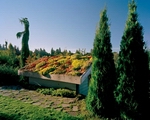Why have Green Roof?
 Installing a green roof
goes a small way to replacing the nature destroyed by building. However, there
are plenty of good reasons to incorporate a green roof into the design of a
building or to install one on an existing building.
Installing a green roof
goes a small way to replacing the nature destroyed by building. However, there
are plenty of good reasons to incorporate a green roof into the design of a
building or to install one on an existing building.
Greenhouse
Effect
Green roofs reduce the
greenhouse effect by absorbing carbon dioxide and producing oxygen. They also
reduce solar reflection. Because of their effect on thermal performance, green
roofs reduce the need for air conditioning which is itself a source of
greenhouse gases.
Reduced
energy consumption
Climate change means that
it is essential that we vastly reduce the impact of building in terms of energy
consumption and therefore carbon emissions into the environment. Since green
roofs have significant insulation properties, providing warmth in the winter
and cooling in the summer, they can have a huge effect on the way a building
performs and should be incorporated into any package aiming to achieve zero or
low carbon targets.
Extended
life of the waterproofing
The waterproofing under a
green roof system is protected from the effects of ultraviolet light, extremes
of temperature and weather. As a result the life of waterproofing is prolonged.
Some planted roofs in the
USA
and
Europe have extended the life of the
waterproofing to 70 years or more!
Noise
reduction
Adding mass to the roof
structure by planting enhances acoustic performance of the roof. Acoustic
performance will vary with the water content of the plant system but sound
transmission through an aluminum standing seam roof for example can be reduced
by up to 40 percent. This benefit increases as the plants grow and mass
increases.
Stormwater
management
In many cities around the
world it has been recognized that the most significant ecological advantage of
roof planting is in stormwater management. Development results in permeable
ground being replaced by impermeable artificial surfaces through which
rainwater can not permeate. The result is that drainage systems in developed
areas are unable to cope with the instant changes in flow rate and volume of
stormwater resulting in flooding and water course contamination.
Since it is difficult to
install water containment measures within urban areas where space is at such a
premium and ground based storage is expensive, keeping the water on the roof
and returning it to the atmosphere is a cost effective solution. Rainwater
retained on green roofs in the substrate and drainage layers is taken up by the
plants and transported from the root to the leaf where it is lost through the
leaf surface - a process known as transpiration. Water is evaporated from the
substrate and plants by the sun. Both processes are accelerated by wind
disruption. Any water that is not retained on the roof is released much more
slowly into the drainage system preventing flooding.
Aesthetic
Value
Aesthetics are perhaps the
most apparent benefit of green roofs. Indeed most of the green roofs built all
over the world, are intensive roofs built for aesthetic or amenity purposes.
Inaccessible extensive green roofs also have aesthetic value, especially when
viewed from surrounding buildings.
Maintenance
Intensive green roofs
require regular maintenance. Simple intensive green roofs, like lawns, might
require mowing and weeding on a weekly or fortnightly basis during the growing
season. Extensive green roofs would normally only require annual visits to
remove rubbish, check fire breaks and drains and in some cases remove unwanted
colonizing plants. The first three years of roof maintenance are usually the
responsibility of the green roof manufacturer. Some ‘wildflower meadows’ on
extensive green roofs may require annual mowing with cuttings removed.






